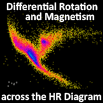Speaker
Leonid L. Kitchatinov
(Institute for Solar-Terrestrial Physics, Irkutsk)
Description
Meridional circulation is driven by non-conservative parts of the centrifugal and
buoyancy forces. Each of the forces alone would drive a flow of hundreds meters per
second. The forces, however, almost balance each other in the so-called thermal wind
balance. The meridional flow results from slight deviation from the balance. The flow
attains its largest velocities in the boundary layers near the top and bottom of the
convection zone, where the balance is violated, and decreases inside the convection
zone. The differential rotation results from angular momentum transport by turbulent
convection and by the meridional flow. Helioseismological rotation law can be
reproduced only if the differential temperature is present with poles slightly warmer
than the equator. Mean-field models predict the surface differential rotation of
solar-type stars to be a function of only two stellar parameters: rotation period and
surface temperature. The differential rotation is predicted to be smaller for smaller
stars. Efficiency of the differential rotation in winding the toroidal fields has,
however, an opposite tendency to increase with decreasing temperature.
Author
Leonid L. Kitchatinov
(Institute for Solar-Terrestrial Physics, Irkutsk)

